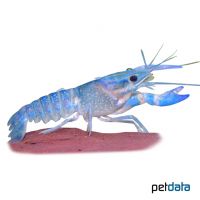Hairy Marron (Cherax tenuimanus)
| Hairy Marron Cherax tenuimanus | |
|---|---|
| Name | Hairy Marron |
| Name Lat. | Cherax tenuimanus |
| Family | Southern Hemisphere Crayfishes |
| Family lat. | Parastacidae |
| Order | Decapods |
| Order lat. | Decapoda |
| Origin | SW-Australia |
| Habitat | Rivers, streams |
| Diet | Crayfish food, leaves, carrion |
| pH | 6.5-8.0 |
| Behavior | Aggressive |
| Keeping | Individual, pair |
| Care Level | Moderate |
| Reproduction | Oviparous |
| Breeding | Moderately difficult |
| Life Span | 4-6 years |
| Protection | No |
| Metric Units | |
| Size | 20-30 cm |
| Temperature | 18-25 °C |
| Hardness | 5-20 °dH |
| Aquarium | ~ 200 l |
| US Units | |
| Size | 8"-12" |
| Temperature | 64-77 °F |
| Hardness | 89-356 ppm |
| Aquarium | ~ 50 gal |
Distribution and habitat
Marron crabs are found exclusively (endemically) in the Margaret River watershed in extreme southwestern Australia, where they live in oxygen-rich water hidden among roots and rocks.
Maintenance
They require a well-structured aquarium with roots, stones and robust plants, with hiding places (caves, crab tubes) and a moderate current. The burrowable substrate of sand or fine gravel should be partially covered with foliage (e.g. sea almond leaves, oak leaves), which also serves as food.
No ammonia, ammonium and nitrite should be detectable in the aquarium water, the nitrate value should not exceed 100 mg/l. To ensure water quality and oxygen content, a filter and heater adapted to the size of the aquarium is required, as well as lighting for the proper day-night rhythm of the animals.
Diet
They are omnivores that feed on animal organisms, carrion and dead plant material. For a balanced diet, feed once daily with a high-quality crayfish food (pellets, sticks) supplemented with insect larvae (live or frozen), fish, crayfish or shrimp meat, and foliage (e.g., sea almond, oak, beech). Occasionally, plant food in the form of spirulina, kelp or scalded leafy vegetables should be offered.
Unaccepted food must be removed after 2-3 hours. Regular and varied feeding promotes health and prevents deficiency symptoms.
Behaviour and compatibility
They behave aggressively within the species, but also towards other crayfish, therefore keeping several pairs or groups is only recommended in a much larger and richly structured tank. They can only be socialized with large shrimps, snails and large fish, but it is better to keep them in a species tank.
Basically, only mutually compatible animals with similar demands on water conditions and water temperature may be socialized.
Reproduction and breeding
The sexes can only be clearly identified by the sexual openings (gonopores) on the underside of the body, which in the male are located at the base of the fourth (last) walking leg. The female carries the eggs (200-400 pieces) under her pleopods (webbed feet) until the young hatch and supplies them with oxygen by movement (fanning). Dead or non-developing eggs are eaten by the female. The young hatch after about 4 weeks. The young crayfish are cannibalistic and reduce each other severely.
Important
Each crab must have at least one cave (e.g. crab tube) of its own in which it can hide and also to be able to molt undisturbed
It can happen that a crayfish is missing a claw. Mostly these are females that have lost a claw during mating. The missing claw slowly grows back during the following molts. The strong claws are also used for digging.
The well-being of the animals should be checked regularly. Temperature should be checked daily, pH, hardness and nitrate levels at least every 14 days. Regular partial water changes are recommended, even if the contaminant level has not yet reached the upper limit. Sudden changes in water quality should be avoided. Newly introduced animals must be accustomed slowly to the water in the aquarium.
Further literature can be found in your pet store.
References
Text: Barbara Pachner; Image: petdata
Source: LUKHAUP & PEKNY (2008): Süßwasserkrebse aus aller Welt, Dähne Verlag; ENGELMANN & LANGE (2011): Zootierhaltung - Tiere in menschlicher Obhut: Wirbellose, Verlag Harri Deutsch
